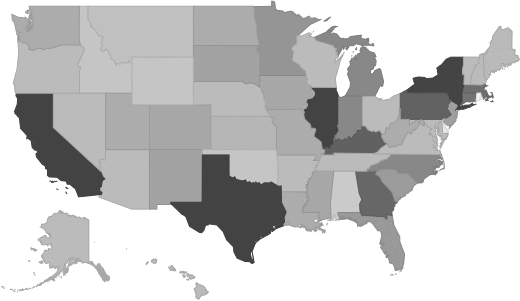Chiropractors Industry - Market Research Report
Industry Overview
This industry comprises establishments of health practitioners having the degree of D.C. (Doctor of Chiropractic) primarily engaged in the independent practice of chiropractic. These practitioners provide diagnostic and therapeutic treatment of neuromusculoskeletal and related disorders through the manipulation and adjustment of the spinal column and extremities, and operate private or group practices in their own offices (e.g., centers, clinics) or in the facilities of others, such as hospitals or HMO medical centers.
Source: U.S. Census BureauMarket Size and Industry Forecast
This research report analyzes the market size and trends in the Chiropractors industry. It shows overall market size from 2020 to the present, and predicts industry growth through 2030. Revenues data include both public and private companies.
| Historical | Forecasted |
|---|
| 2020 | 2021 | 2022 | 2023 | 2024 | 2025 | 2026 | 2027 | 2028 | 2029 | 2030 |
|---|
| Market Size (Total Revenue) | Included in Report |
| % Growth Rate |
| Number of Companies |
| Total Employees |
| Average Revenue per Company |
| Average Employees per Company |
Source: U.S. government financial dataIndustry Revenue ($ Billions)

Industry Forecast ($ Billions)

Advanced econometric models forecast five years of industry growth based on short- and long-term trend analysis. Market size includes revenue generated from all products and services sold within the industry.
Geographic Breakdown by U.S. State
Market size by state reveals local opportunity through the number of companies located in the region. Each state's growth rate is affected by regional economic conditions. Data by state can be used to pinpoint profitable and nonprofitable locations for Chiropractors companies in the United States.
Chiropractors Revenue by State

Distribution by Company Size
| Company Size | All Industries | Chiropractors |
|---|
| Small Business (< 5 Employees) | Included |
| Small Business (5 - 20) |
| Midsized Business (20 - 100) |
| Large Business (100 - 500) |
| Enterprise (> 500) |
Chiropractors Industry Income Statement (Average Financial Metrics)
Financial statement analysis determines averages for the following industry forces:
- Cost of goods sold
- Compensation of officers
- Salaries and wages
- Employee benefit programs
- Rent paid
- Advertising and marketing budgets
The report includes a traditional income statement from an "average" company (both public and private companies are included).
| Industry Average | Percent of Sales |
|---|
| Total Revenue | Included |
| Operating Revenue |
| Cost of Goods Sold (COGS) |
| Gross Profit |
| Operating Expenses |
| Operating Income |
| Non-Operating Income |
| Earnings Before Interest and Taxes (EBIT) |
| Interest Expense |
| Earnings Before Taxes |
| Income Tax |
| Net Profit |
Average Income Statement

Cost of Goods Sold
Salaries, Wages, and Benefits
Rent
Advertising
Depreciation and Amortization
Officer Compensation
Net Income
Financial Ratio Analysis
Financial ratios allow a company's performance to be compared against that of its peers.
| Financial Ratio | Industry Average |
|---|
| Profitability Ratios | Included |
| Profit Margin |
| ROE |
| ROA |
| Liquidity Ratios |
| Current Ratio |
| Quick Ratio |
| Activity Ratios |
| Average Collection Period |
| Asset Turnover Ratio |
| Receivables Turnover Ratio |
| Inventory Conversion Ratio |
Products and Services Mix
Product lines and services in the Chiropractors industry accounting for the largest revenue sources.
| Product Description | Description | Revenue
($ Millions) |
|---|
| Industry total | Included |
| Patient care |
| Patient care - musculoskeletal & connective tissue |
| Patient care - injuries & adverse affects |
| Patient care - nervous system & sense organ disorders |
| Resale of merchandise |
| Patient care - signs & symptoms |
| Resale - all other merchandise |
| All other patient care |
| Rental or lease of goods and/or equipment |
Salary information for employees working in the Chiropractors industry.
| Title | Percent of Workforce | Bottom Quartile | Average (Median) Salary | Upper Quartile |
|---|
| Management Occupations | 1% | Included |
| General and Operations Managers | 0% |
| Healthcare Practitioners and Technical Occupations | 25% |
| Health Diagnosing and Treating Practitioners | 24% |
| Chiropractors | 22% |
| Chiropractors | 22% |
| Healthcare Support Occupations | 28% |
| Other Healthcare Support Occupations | 28% |
| Massage Therapists | 9% |
| Massage Therapists | 9% |
| Miscellaneous Healthcare Support Occupations | 19% |
| Medical Assistants | 19% |
| Office and Administrative Support Occupations | 44% |
| Financial Clerks | 5% |
| Information and Record Clerks | 12% |
| Receptionists and Information Clerks | 12% |
| Receptionists and Information Clerks | 12% |
| Secretaries and Administrative Assistants | 15% |
| Secretaries and Administrative Assistants | 15% |
| Medical Secretaries | 11% |
| Other Office and Administrative Support Workers | 9% |
| Office Clerks, General | 8% |
| Office Clerks, General | 8% |
Government Contracts
The federal government spent an annual total of
$1,040,504 on the chiropractors industry. It has awarded 18 contracts to 10 companies, with an average value of $104,050 per company.
Top Companies in Chiropractors and Adjacent Industries
| Company | Address | Revenue
($ Millions) |
|---|
Included |



